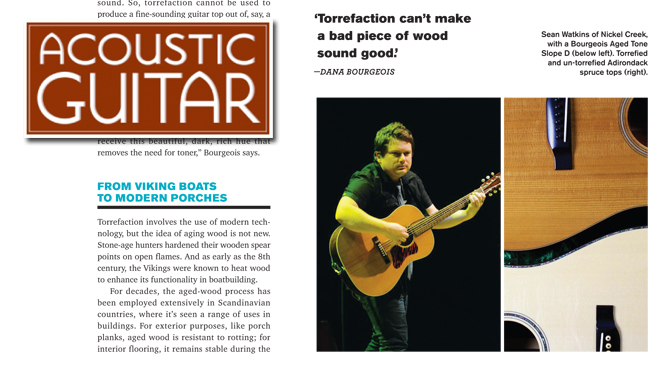Review & Articles
Dana Bourgeois on Torrefaction for AG
From the September 2014 issue of Acoustic Guitar
Read the PDF of the Full Article Here
Everything New is Old Again
BY ADAM PERLMUTTER
Guitar builders are using a technique called torrefaction to accelerate the wood-aging process for better tone and stronger instruments
A few years ago, the luthier Dana Bourgeois—an AG contributing columnist—received a sample of spruce, which he later fash- ioned into a guitar’s sound-board. After the instrument was completed, a violin-making friend asked Bourgeois to shine a flashlight on the top, and to comment on its permeability to light.
When Bourgeois reported that it was opaque, his friend said, “Congratulations, you’ve discov- ered the holy grail of violin forgery.”
The violin maker was referring to the dark side of instrument building, in which counterfeit- ers make copies of rare and expensive 18th-cen- tury violins with imitation scratches, varnish wear, and a variety of other simulated tricks. One thing that has historically been impossible to fake, though, is the way wood’s structure transforms as it ages; a soundboard or back that admits light is a dead giveaway to an instrument’s forgery. But for the spruce top on Bourgeois’ guitar, the luthier had used a wood-aging treatment called torrefac- tion—an organic process that renders fresh wood nearly indistinguishable from wood that has aged naturally. That’s why the light had a hard time peeping through.
As acoustic-guitar makers turn to period-correct materials like hide glue and varnish finishes to create guitars that emulate their prewar counterparts, it is only natural that tor- refied wood is gaining traction.
Bourgeois has gotten satisfying results from these materials, as have bigger companies, including Martin and Yamaha. “This is probably the most important technological advance I’ve seen in decades of guitar making,” Bourgeois says.
But is the aged-wood look for a guitar just a fad, like 1980s stonewashed jeans? Hardly, says Bourgeois. Torrefaction doesn’t just make a guitar look old, it gives it the opened-up sound that’s prized in actual vintage guitars. “Luthiers are just beginning to discover its depth of possibilities,” he says.
In his Aged Tone series, Bourgeois offers dreadnoughts and OMs with torrefied sound- boards, finished with Isocyanate, a material that mimics the thinness and hardness of the aged nitrocellulose lacquer which, according to many builders, contributes to a vintage guitar’s tone. Bob Minner, a master flatpicker known for his work with country singer Tim McGraw, owns both a specially ordered Bourgeois slope-shouldered dreadnought and an 00 from the Aged Tone series.
“I’ve got a bunch of vintage guitars that I love, and I’d stack up these new guitars against any comparable old model,” Minner says. “The great thing about them is that you get this dry, aged tone.”
ROASTED WOOD
Torrefaction is a process by which wood is heated in a controlled environment, cooking off the volatiles—the oils, sugars, and resins that naturally vacate the wood but only after many decades of drying. “Imagine a cross section of raw bacon, part meat and part fat,” says Tim Teel, director of instrument design at C.F. Martin & Co. “Then visualize a cooked piece, in which the fat has been rendered out. This is kind of what happens with a piece of wood that’s been torrefied.”
“It’s an environmentally friendly, non-chem- ical process that yields excellent musical results,” says Armando Vega, project manager for Yamaha, which calls its wood-aging process
Acoustic Resonance Enhancement.
In most commercial applications, wood is torrefied inside a kiln or chamber, whose inte¬rior is low in oxygen and can withstand high temperatures. Everything is monitored with sensors programmed to respond to characteris¬tics unique to different species of wood.
A typical procedure involves first slowly heating the wood to about 250 degrees, keeping it there for 20 hours, and then gradually lower¬ing the heat until nearly all of the moisture is removed. The next step is to reheat the wood to about 400 degrees, lowering the temperature a final time while using water vapor to add mois¬ture. This last step ensures that the end product is useable by woodworkers. Wood that is too brittle will not work.
Torrefied wood has a honeycomb-like cellular structure resembling that of timber that’s had many decades to transform. Because of this, in Bourgeois’ assessment, it has a more opened-up sound. “If properly treated, its stiffness-to-weight ratio improves,” he says. “This results in an enhanced velocity of sound—the quickness with which sound travels through wood—which pro¬duces the vintage tone that’s typically been all but elusive in a new instrument.”
Of course, not all old guitars sound stellar, and that’s because not all wood has the proper¬ties that make it an excellent transmitter of sound. So, torrefaction cannot be used to produce a fine-sounding guitar top out of, say, a piece of suboptimal spruce. “Torrefaction can’t make a bad piece of wood sound good,” Bour¬geois says. “For use in guitars, the process has to start with a selection of fine tonewood.”
The natural spruce tops of new, vintage-style guitars are typically treated with aging toners that darken the wood to simulate oldness. But in the torrefaction process, as a wood’s struc¬ture changes, so does its coloration; therefore, the aged look is more authentic. “Spruce can receive this beautiful, dark, rich hue that removes the need for toner,” Bourgeois says.
FROM VIKING BOATS TO MODERN PORCHES
Torrefaction involves the use of modern tech¬nology, but the idea of aging wood is not new. Stone-age hunters hardened their wooden spear points on open flames. And as early as the 8th century, the Vikings were known to heat wood to enhance its functionality in boatbuilding.
For decades, the aged-wood process has been employed extensively in Scandinavian countries, where it’s seen a range of uses in buildings. For exterior purposes, like porch planks, aged wood is resistant to rotting; for interior flooring, it remains stable during the changes that can cause expansion or contraction in untreated wood, resulting in buckling and other structural problems. And as with guitars, torrefied wood in other applica¬tions is sometimes used to simulate oldness.
“There’s a historic district of Amsterdam where the buildings have been around for 500 years,” Bourgeois says. “Torrefied wood has worked quite effectively for maintenance, as it looks aesthetically correct.”
In Finland, torrefaction is known as “thermo treatment” and has been used by various wood producers since it was patented in 1990. The Tampere University of Technology, together with a handful of Finnish instrument makers, initiated a study of thermo-treated tonewoods in 1996, culminating in a 2002 paper reporting the musical benefits of the process. This was a revelation for many builders in that country.
“Juha Ruokangas started torrefying every¬thing in his instruments,” says Bourgeois, referring to the luthier who specializes in electric guitars and basses. “Even organ builders found it was great for church instruments, whose cabi¬nets were prone to swelling in those large halls.”
THE MISSING ELEMENT
Teel often found something lacking when he compared high-quality replicas to the original Martin guitars. He just couldn’t quite pinpoint what it was. Two years ago, when Martin used a sample of torrefied Sitka spruce for the soundboard of an HD-28, he figured it out.
“It had the missing element,” Teel says. “A really dry, chimey, ringing tone that is the hall¬mark of a great vintage guitar.”
Martin donated the HD-28 to a charity auction whose organizers were not careful when handling the instrument. Displayed in a case under a hot light, the guitar had become dangerously dehydrated, developing sharp fret ends but just a hairline crack on the sound¬board. Considering the circumstances, it was a relatively minor injury.
“The winner sent us the guitar for revitaliza¬tion,” Teel says, “and one of our repair guys got confused. The department sees guitars that have been through so many different adverse circum¬stances, and on a guitar as dry as the HD-28 had become, much more extensive soundboard crack¬ing would be expected. The torrefied spruce really minimized the damage on this guitar.”
Bourgeois took one of his own treated guitars home in the dead of a particularly harsh Northeastern winter. “I didn’t bother to humidify the guitar, but throughout the winter and into the spring, it barely moved; this just blew me away,” he says. “I lent it to Courtney Hartman [of the string band Della Mae] and she took it out on the road without even a setup needed.”
In its factory, Martin has an environmental chamber, which subjects test guitars to a wide range of temperatures and humidity levels for the purpose of quality control. That chamber has confirmed the stability of other guitars built from torrefied woods. “We’ve tried a couple guitars with back and sides made from torrefied maple, which holds up great and sounds excel-lent while adding a beautiful amber color to the wood,” Teel says.
NOT A REPLACEMENT
Though it would be possible to torrefy all woods used to build an instrument, the process reportedly causes denser tropical specimens, such as rosewoods, to become brittle and sus¬ceptible to cracking. Instrument makers have so far focused mainly on applying torrefaction to the top, which is usually considered the most important tone-producing wooden part of an acoustic guitar. Bourgeois has found that theprocess works particularly well for Adirondack spruce, because of its hardiness.
“Before we use a piece of torrefied wood, we cut off a little sliver, to examine its fibers; longer fibers will have more integrity,” Bourgeois says. “We feel on safe ground with torrefied Adiron¬dack. It tends to be pretty tough, generally with better long-grain integrity than the European species commonly used in guitar building.”
Martin faces the conundrum of recreating its original designs with dwindling supplies of tradi¬tional materials. Five years ago, when the company began searching for an alternative to ebony for its bridges and fingerboards, torrefied wood seemed like a promising solution.
“We got some torrefied maple and had it ebonized, or darkened, for the appropriate look. But we weren’t quite satisfied with the results,” Teel says. “The wood was too lightweight and not very efficient, tonally, which torrefaction could not address in this application. The fin¬gerboard and bridge are key in transmitting string vibrations efficiently into the body—for that famous Martin growl—and torrefied maple just didn’t cut it.”
Despite its successful experiment with that HD-28, Martin has learned that for all of the enhancements, torrefied wood can be more dif¬ficult to work with than non-aged wood. “It becomes a little more brittle, so extra care is needed in the manufacturing process,” Teel says. “Because torrefied wood loses cellular material, it doesn’t have the spongelike quality that new wood does, and therefore, if a little dent is made on a guitar that’s being built, it can’t easily be steamed out.
“It’s not a direct replacement for normal spruce,” Teel adds.
So far, Martin’s experimentations with torre¬fied woods have resulted in only one model, the limited-edition CS-00S-14, with a treated Swiss spruce top. The guitar blends traditional ele¬ments—a 12-fret 00 body and hide-glue con¬struction—with modern touches like a carbon-fiber neck reinforcement and Fishman Aura VT electronics. “We’ve done a lot of testing on torrefied woods and so far haven’t seen any¬thing negative associated with it. But we’re tip¬toeing into the pond, so to speak,” Teel says.
As new torrefied guitars hit the market, some players who feel that a guitar should earn its age will worry about how a torrefied guitar will stand up over time; others will suspect the process is a gimmick. The real test is whether players and col-lectors of all stripes embrace guitars made with torrefied woods in the way that a small number of devotees like Bob Minner have.
“Quote me on this,” Minner says. “My Bourgeois guitars with torrefied tops will be coveted on the vintage market long after I’m gone.” AG

